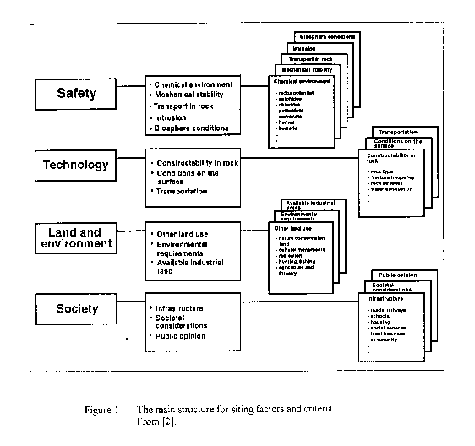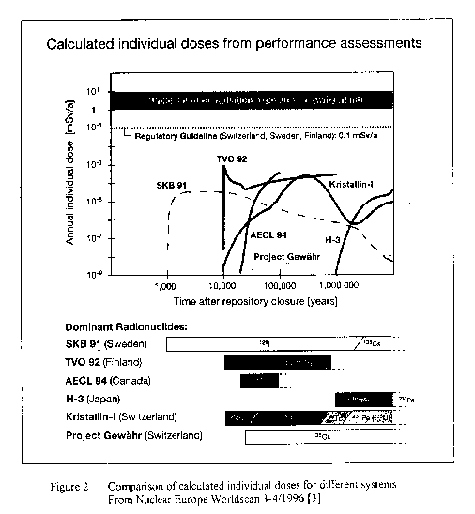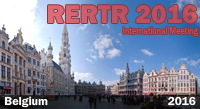IAEA/USA Interregional course on
Preparations to Ship Spent Nuclear Fuel (1997)
Final Storage of MTR Fuel
in Deep Rock Repository
![]() PDF version available
PDF version available
DOWNLOAD full paper in PDF format.
Contact:
Mr. Erik Jonnson
Studsvik Nuclear AB
S-611 82 Nykoeping
Sweden
Tel.: +46-155-221768
Fax: +46-155-263070
E-mail: none
IAEA/USA Interregional Training Course
Technical and Administrative Preparations Required for Shipment of Research Reactor Spent
Fuel to its Country of Origin
13-24 January 1997
Argonne, IL
L.13.11
Final Storage of MTR Fuel
in Deep Rock Repository
Erik B. Jonsson
Studsvik Nuclear AB
Summary
The back end of the research reactor fuel cycle had up till 1988 been solved
by the possibility to return the spent fuel to US for final deposition there.
The environmental issue raised in 1988 was not easily solved by US-DOE. It took
8 years until the final EIS ( Environmental Impact Statement) was published
and approved in May 1996. Meanwhile the lack of back end had caused problems
for many research reactors, their pools had reached the maximum capacity. Many
faced the risk of having to close their reactor operation.
The R2 reactor operators were lucky to have access to a three-pool storage
facility, so space was not the problem. Instead the authorities raised questions
on the physical protection of the HEU fuel and they also requested Studsvik
to accomplish a plan for alternative back end solutions.
The alternatives we had were beside the return of the spent fuel, reprocessing
of the fuel or final direct disposal. These alternatives were investigated and
presented here is some of the results from the study of direct disposal of LEU
fuel in the Swedish Deep Rock Repository, KBS-3. This repository is planned
to accommodate most of the spent fuel from all of the 12 Swedish power reactors.
The total amount of BWR and PWR fuel is estimated to be 7200 metric tonnes of
oxide fuel.
The research rector fuel does not conform with the power reactor fuel, the dimensions, enrichment and corrosion resistance are quite different. Some of these differences do not influence the safe disposal, but the higher enrichment and the more corrosive aluminium cladding have to be considered in the evaluation of the repository for MTR fuel.
Content
2 Description of the KBS-3 Deep Rock Repository
3 System evaluation for MTR Fuel
4 Future Development for LEU fuel
1 Introduction
The Atoms for Peace Program in 1955 granted supply of enrichment services to countries that promised not to develop their own enrichment process. The Swedish R2 reactor of MTR type was started under these premises in 1960. The supply of high enriched uranium to the reactor was under contract with DOE with specific request on the return of the spent fuel for reprocessing. This policy from the US side ceased in late 1988 due to new US requirements of environmental documentation. DOE started working on an Environmental Impact Statement, but withdraw it after some critical comments. The storage space at the research reactors became in this period overfilled and DOE managed to proceed with an emergency shipment in 1994. Then in the spring of 1996 came the long awaited EIS[1], that through the ROD ( Record of Decision) on May 19, 1996 stated that US-DOE was prepared to take back all research reactor HEU and LEU of US origin for the next 10 years.
The long period of uncertainty had forced us in Sweden to consider alternatives for the back end of the fuel cycle. Reprocessing of HEU was studied as well as final disposal according to the Swedish deep rock repository method.
The limited time for return of fuel to US has also made it clear that safe methods for the final disposal must be developed for the MTR fuel as well as for the power reactors. To verify such a disposal means tests over long time periods to be able to draw conclusions on the slow processes involved when the fuel is stored forever.
2 Description of the KBS-3 Deep Rock Repository
The Swedish system for final direct disposal of spent nuclear fuel, KBS-3[2], is based on storage of the fuel without reprocessing at large depth (around 500 m) in solid crystalline rock. The same concept has also been studied in some other countries, Finland, Canada and Switzerland. The spent fuel will be placed inside canisters in boreholes. A layer of betonite clay will isolate the canisters from the groundwater and also in case of a mechanical failure of the canister it will form a barrier to radionuclide migration. The canisters will be made of stainless steel and they will be clad with thick solid copper or in the AECL case titanium layer.
The R&D on deep rock repository has been going on for over a decade after Sweden abandoned the reprocessing option. As is shown in the latest annual report from SKB [2] the work has covered a wide variety of technical items to solve the safe long time disposition of radioactive waste. The repository is the final destination of the back end system, so first systems for transport and intermediate storage of the fuel has been developed and built. Under development and evaluation is then the final step with encapsulation and transport to the deep rock repository, where the canisters are placed in the boreholes, which are then filled with betonite. When all spent fuel is taken care of the whole repository is backfilled with quartz sand and/or crushed rock.
One important part of the system is the siting process. Siting criteria has been formulated and general and specific feasibility studies has been started. The siting criteria are based on: Safety, Technology, Land and Environment and the Social aspects. The structure of the siting process is shown in Figure 1.
The main effort in the development of the system has been in the geoscience field, the structure and behaviour of the rock, coupled with the chemistry of the water in the fractured rock. This research has been concentrated to the Äspö Hard Rock Laboratory, which consist of a tunnel system reaching down to 450 m. Here the hydraulic conditions for water movement is studied together with the hydrogeochemistry of the water at that depth. The investigations have resulted in mathematical models for the rock stress in a thermal-hydro-mechanical model. The thermal conditions are important as the repository will gain the decay power from the spent fuel.
Natural analogues have been investigated, e.g. the natural reactor zone in Oklo, Gabon, where it is possible to trace the migration of fission products over a million of years.
All research shows that the integrity of these systems are high with an expected lifetime of the canister of several thousands of years. The only significant migration of the activity to the surface is considered to be through the slow motion of the groundwater in the sparsely fractured rock.
Calculations of the predicted release from these systems show[3], compare Figure 2, that the maximum doses after some tens of thousands of years are estimated to be between 0.01 to 1 Sv/year, which is at least 3 decades lower than the natural radiation exposure from the ground today.
3 KBS-3 System evaluation for MTR Fuel
Two fundamentally different approaches have been made for storing the spent power reactor fuel. The first method involves encapsulation and storage under dry condition. This condition can be found in desert areas and salt mines. These areas have been dry for long periods even in a geological time scale and should thus form an excellent environment for storing the spent fuel for 100,000 years or more. The second method is based on storage in deep rock. In that case the spent fuel have to be caned and isolated from the ground water that penetrates the rock. This method will be used for final direct disposition of the Swedish power reactor spent fuel and has also been chosen in a couple of other countries as preferred disposal method[3].
In connection with the conversation studies for the introduction of LEU fuel at the R2 reactor in 1988 there was also a study of the possibility to make a direct disposal of the aluminium clad U3Si2 fuel using the current Swedish model, KBS-3. The main conclusion of the study was that further research had to be performed. The uncertainties were mainly on the corrosion rate of the cladding and subsequent leaching rate of the fission products and the transuranium elements in case of a groundwater intrusion into the canister. Some concern was also raised on the risk for a secondary criticality if the dissolved uranium is concentrated in some rock cavity. The investigation stopped at that point.
Last year the operating licence of the R2 was renewed and in that context the authorities asked for further studies of alternative back end solutions and direct disposal together with the power reactor fuel. A survey of the situation since the last study showed that the direct disposal model, SKB91, had changed only marginally. The decay heat and radioactivity from the proposed MTR loading of the canister are much lower than for a comparable canister with PWR fuel. Some new data for the long term stability of the aluminium and alumniumoxide was found[4], but the main objections to the direct disposal of the R2 silicide fuel remained. The high reaction rate of the aluminium metal in granite groundwater that could penetrate the betonite clay might in some cases cause considerable pressure increase from the formation of hydrogen gas. There has also been added concern that the aluminium clad fuel could jeopardise the total integrity of the disposal site, which of course is unacceptable.
4 Future Development for LEU fuel
The present take back of spent MTR fuel will expire in May 2006 after that the back end of the MTR fuel cycle has to be solved by other means. There are three ways to go, reprocessing ( with storage of High Level Waste), final storage under dry or deep rock conditions. In some countries the deep rock repository has been developed to a probable way of storing the power reactor fuel. It would be an advantage to use the same concept for MTR fuel.
Two areas must be penetrated:
- Al corrosion, can the corrosion of the aluminium cladding and uraniumsilicide be accepted or must we change to a zirconium clad oxide fuel.
- Criticality, are solid and semi-soluble neutron absorbers adequate.
The main obstacle can be the power industry, we must pursuade them that continued research reactor operation is necessary in the future and therefore the back end must be solved.
5 References
1 Final Environmental Impact Statement, Proposed Nuclear Weapon's Non-proliferation
Policy Concerning Foreign Research Reactor Sent Nuclear Fuel, DOE/EIS-0218F,
Feb. 1996
2 SKB Annual Report 1995, SKB Tech. Report 95-37
3 Neall F. B., Putting HLW performance assessment results into perspective.,
Nuclear Europe Worldscan 3-4/1996
4 Report from the Advanced Neutron Source (ANS) Aluminium,
Cladding Corrosion Workshop 21(5), 20451 INIS






